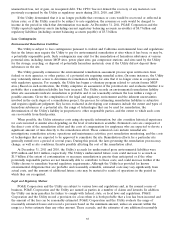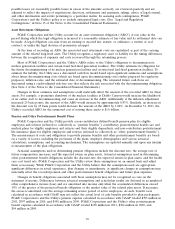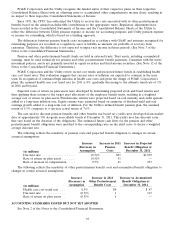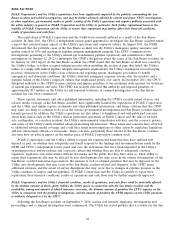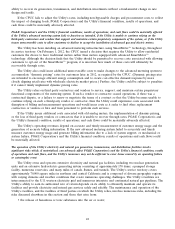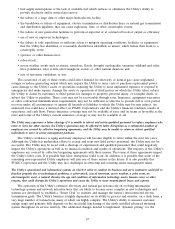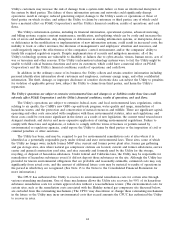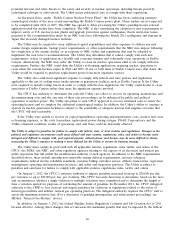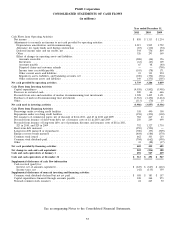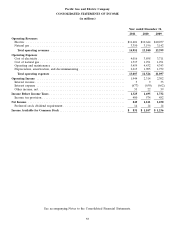PG&E 2011 Annual Report Download - page 49
Download and view the complete annual report
Please find page 49 of the 2011 PG&E annual report below. You can navigate through the pages in the report by either clicking on the pages listed below, or by using the keyword search tool below to find specific information within the annual report.The Utility’s costs to remediate groundwater contamination near the Hinkley natural gas compressor site and to abate the
effects of the contamination, have had, and may continue to have, a material effect on PG&E Corporation’s and the Utility’s
financial conditions, results of operations, and cash flows.
The Utility is legally responsible for remediating groundwater contamination caused by hexavalent chromium
used in the past at the Utility’s natural gas compressor site located near Hinkley, California. As discussed above
under ‘‘Environmental Matters,’’ several orders have been issued to require the Utility to take measures to remediate
the underground chromium plume and abate the effects of the contamination on the environment. In October 2011,
the Regional Board issued an amended clean up and abatement order that the Utility has challenged. The Regional
Board also is evaluating final remediation alternatives submitted by the Utility and is expected to issue a decision on
the final remediation plan in July 2012. The amount of future remediation costs will depend on many factors,
including when and whether the Regional Board certifies a final remediation plan, the extent of the groundwater
chromium plume, the levels of hexavalent chromium the Utility is required to use as the standard for remediation,
and the scope of requirements to provide a permanent water replacement system to affected residents. Since these
costs are not recoverable through rates or insurance, future increases to the Utility’s provision for its remediation
liability at the Hinkley site will impact PG&E Corporation’s and the Utility’s financial condition and results of
operations.
The Utility’s future operations may be impacted by climate change that may have a material impact on PG&E Corporation’s
and the Utility’s financial condition, results of operations, and cash flows.
A report issued on June 16, 2009 by the U.S. Global Change Research Program (an interagency effort led by the
National Oceanic and Atmospheric Administration) states that climate changes caused by rising emissions of carbon
dioxide and other heat-trapping gases have already been observed in the United States, including increased frequency
and severity of hot weather, reduced runoff from snow pack, and increased sea levels. In December 2009, the EPA
issued a finding that GHG emissions cause or contribute to air pollution that endangers public health and welfare.
The impact of events or conditions caused by climate change could range widely, from highly localized to worldwide,
and the extent to which the Utility’s operations may be affected is uncertain. For example, if reduced snowpack
decreases the Utility’s hydroelectric generation, there will be a need for additional generation from other sources.
Under certain circumstances, the events or conditions caused by climate change could result in a full or partial
disruption of the ability of the Utility—or one or more of the entities on which it relies—to generate, transmit,
transport, or distribute electricity or natural gas. The Utility has been studying the potential effects of climate change
on the Utility’s operations and is developing contingency plans to adapt to those events and conditions that the
Utility believes are most significant. Events or conditions caused by climate change could have a greater impact on
the Utility’s operations than the Utility’s studies suggest and could result in lower revenues or increased expenses, or
both. If the CPUC fails to adjust the Utility’s rates to reflect the impact of events or conditions caused by climate
change, PG&E Corporation’s and the Utility’s financial condition, results of operations, and cash flows could be
materially affected.
The operation and decommissioning of the Utility’s nuclear power plants expose it to potentially significant liabilities and
capital expenditures that it may not be able to recover from its insurance or other sources, adversely affecting PG&E
Corporation’s and the Utility’s s financial conditions, results of operations, and cash flows.
The operation of the Utility’s nuclear generation facilities expose it to potentially significant liabilities from
environmental, health and financial risks, such as risks relating to the storage, handling and disposal of spent nuclear
fuel, the release of radioactive materials caused by a nuclear accident, seismic activity, natural disaster, or terrorist
act. There are also significant uncertainties related to the regulatory, technological, and financial aspects of
decommissioning the nuclear generation plants when their licenses expire. The Utility maintains insurance and
decommissioning trusts to reduce the Utility’s financial exposure to these risks. However, the costs or damages the
Utility may incur in connection with the operation and decommissioning of nuclear power plants could exceed the
amount of the Utility’s insurance coverage and nuclear decommissioning trust assets. In addition, as an operator of
the two operating nuclear reactor units at Diablo Canyon, the Utility may be required under federal law to pay up to
$235 million of liabilities arising out of each nuclear incident occurring not only at the Utility’s Diablo Canyon
facility but at any other nuclear power plant in the United States.
The NRC oversees the licensing, construction, and decommissioning of nuclear facilities and has broad authority
to impose requirements relating to the maintenance and operation of nuclear facilities; the storage, handling and
disposal of spent fuel; and the safety, radiological, environmental, and security aspects of nuclear facilities. The NRC
has adopted regulations that are intended to protect nuclear facilities, nuclear facility employees, and the public from
45


